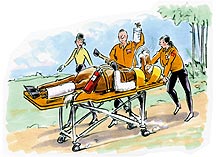|
horse stepping on a nail that imbeds itself in its hoof are good. Generally
speaking, it is better to keep the nail in the hoof to ward off infection,
unless you have a long way to travel, in which case you will need to remove the
nail. If you decide to remove the nail while still away from your stable, make
sure that you mark its location and protect the hoof to keep it as clean and dry
as possible so as not to worsen the situation. The penicillin will come in handy
now as a first line of defense against infection, while the duct tape will
protect the bottom of the hoof against dirt, mud and other items that might lead
to infection.
 On the other hand, if the horse should experience a leg wound, you will want
to use a piece of cloth and duct tape to prevent infection. Do not wrap the limb
so tight that you cut of circulation since that will create a host of other
problems. If possible, a cold creek is a great mode of hydrotherapy and not only
will you be able to clean out any wounds but you will also be able to stave off
inflammation, keeping the animal more comfortable. Should the injury be higher
than the shoulder, you will need to secure a cloth or towel to the area with
bungee cords. It is imperative to prevent flies and other parasites from gaining
access to the wound. This is true even if the wound should be a puncture wound.
You might even want to go ahead and use the syringe of your first aid kit to
spray penicillin into the wound. On the other hand, if the horse should experience a leg wound, you will want
to use a piece of cloth and duct tape to prevent infection. Do not wrap the limb
so tight that you cut of circulation since that will create a host of other
problems. If possible, a cold creek is a great mode of hydrotherapy and not only
will you be able to clean out any wounds but you will also be able to stave off
inflammation, keeping the animal more comfortable. Should the injury be higher
than the shoulder, you will need to secure a cloth or towel to the area with
bungee cords. It is imperative to prevent flies and other parasites from gaining
access to the wound. This is true even if the wound should be a puncture wound.
You might even want to go ahead and use the syringe of your first aid kit to
spray penicillin into the wound.
Leg fractures are trickier, and you will most likely have to rely on whatever
materials are nearby where the accident occurred to help support the leg. Ensure
that the limb is properly padded and then stabilize it with a tree limb. The
goal is to diminish the chance of further damage by getting the animal to the
veterinarian as soon as possible without adding any more weight to the leg than
is absolutely necessary.
In the case of a snakebite, you will notice that the area around the bite wound
will swell up considerably almost immediately after the bite occurs. Away from
your stable, the best first aid you can give to the animal is a quirt of
penicillin and hydrotherapy in a nearby creek. Because of the potential for life
threatening reactions to the venom, it is suggested that you treat every snake
as being potentially poisonous, and you will need to ensure that the animalís
nasal passages do not swell shut. To this end you can use a couple of precut
pieces of garden hose and insert them into the nostrils. Conversely, the cases
of the syringes will be useful as well.
If the eye is injured, simply protect it with a cotton covering until you can
have the animal seen by your vet. Another scary situation may occur if the horse
suddenly shows symptoms of colic while you are out and about. While it is true
that horses will get better eventually if there is no direct treatment, but you
will still want to help the animal. Fresh water is helpful, so is rest. Prior to
taking off on that backcountry ride, make sure the animal is watered
appropriately.
As you are setting out on your trip, make sure that you let other people know
where you will be going, how long you expect to be gone, and which trail you are
most likely to use. Thus, if you are late in coming back, they may send someone
out to meet you and may help you with any unforeseen problems. Use a saddle that
distributes the weight evenly across the animalís back, such as a western
saddle, and use pommel bags rather than those that are tied behind the cantle.
Plan for inclement weather, even if skies are blue and add a halter and a lead
rope to your bags to make sure you can lead the animal if needed. Even though in
todayís technology age everyone has a cell phone, do not count on actually
having a signal in the backcountry. You are still your horseís best chance at
surviving an emergency.

|